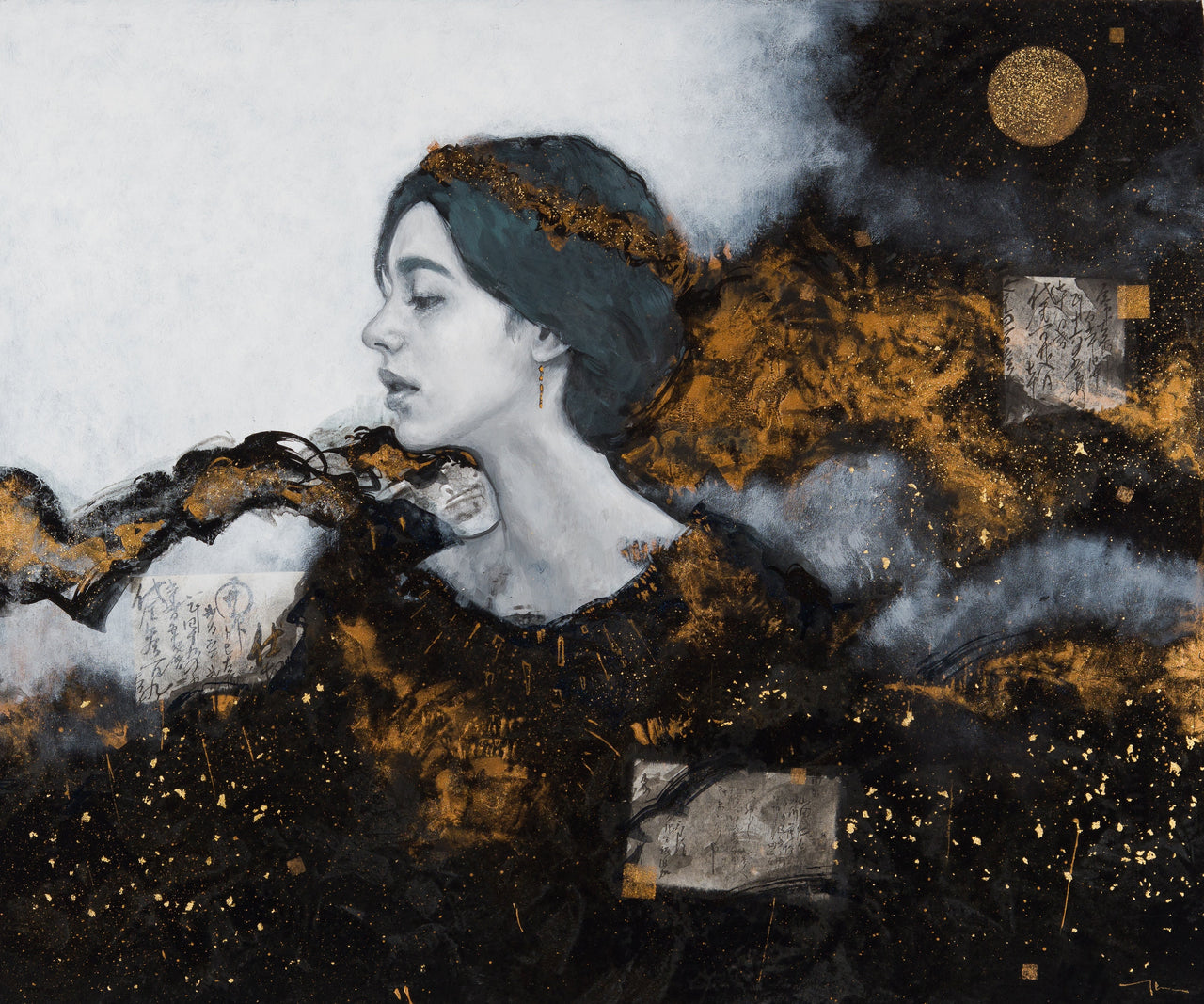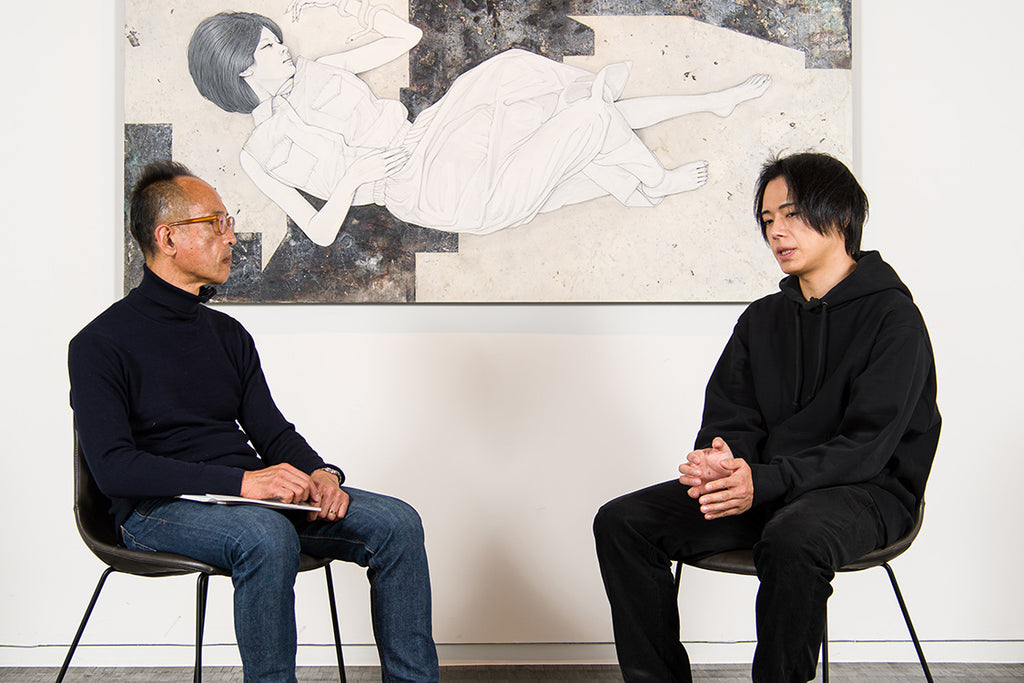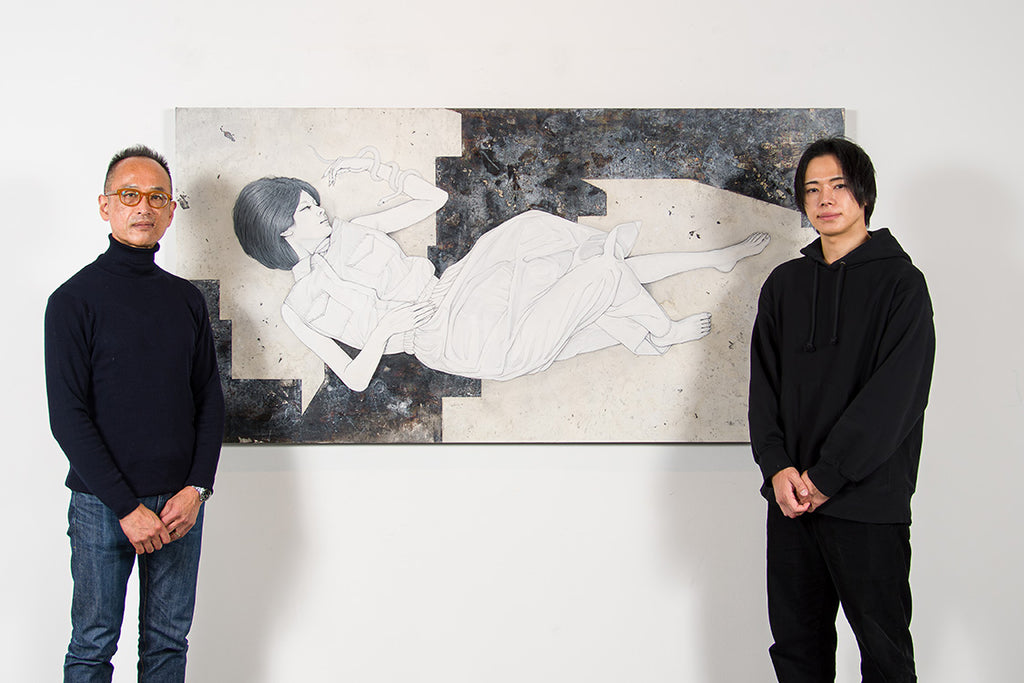ARTICLES
Kenki Tsujimoto’s Art: Fragments of Trajectory and Emotion — The Resonance of Mineral Pigments and Acrylic
2024.10.01
INTERVIEW

Clad in black, white, and golden shimmer, the figures in Tsujimoto’s paintings stand silently, gazing out with eyes filled with meaning. Sometimes their expressions appear sorrowful, at other times emotionless, yet their determined gaze always carries a sense of melancholy and strength. Tsujimoto’s bewitching, ethereal works weave "trajectory" through the layering of time and memory, expressed through his figures and materials.
By interweaving traces left by people and the cycles of nature, his works stand at the intersection of past and future, embodied through refined techniques and a unique artistic vision. Through an interview with artist Kenki Tsujimoto, we delve into the essence of his techniques and the aesthetic consciousness behind his creations.
Kenki Tsujimoto’s Trajectory: A World Woven from Memory and Traces

Kenki Tsujimoto, Scent of Dawn, 2024, 60.6 × 72.7 cm, acrylic, natural mineral pigments, gold leaf, ancient documents (1870).
Kenki Tsujimoto’s work deeply reflects the theme of “trajectory.” He draws inspiration from ancient documents, myths, and figures of plants and animals shaped over time by history and nature. These are not mere symbols but embody universal messages transcending time, forming the core of his art.
“When I choose motifs like ancient documents, myths, or plants and animals, I focus on the symbols and stories behind them. The traces of history and nature carry universal messages that resonate even today and fascinate me.” Tsujimoto explains.
These “traces” — signs of life, reverence for nature, and the monumental events of the natural world — contain both fleeting and eternal qualities, evoking in viewers the passage of time and the weight of memory.
The Foundation of Creativity Built During His Art School Days

In the process of creation.
In 2007, Kenki Tsujimoto won the Yataro Noguchi Prize at the Kenten Nagasaki Exhibition, the youngest to do so. In 2013, he received the Kenzo Matsuura Prize at the Showa-kai Exhibition (hosted by Nichido Gallery), and has since made his mark at group exhibitions across various locations. The foundation of his technique lies in his independent studies and relentless practice during his youth. Recalling his time at the local art school in his hometown, where he honed his skills in oil painting and drawing, Tsujimoto says, “I was immersed in painting from morning till night, 365 days a year.”
“My experience designing my curriculum and constantly moving the brush has become the foundation of my current technique. The fusion of traditional methods and my sensibility has impacted my style.” Tsujimoto notes. In retrospect, the limited external influences during his youth fostered his creativity and provided the groundwork for his deep artistic exploration.
The Deep, Rich Textures Created by Mineral Pigments and Acrylic: Kenki Tsujimoto’s Creative Process

Inter×Faces / Whitestone Ginza New Gallery
In Kenki Tsujimoto’s work, the choice of the medium plays a crucial role. By combining mineral pigments with acrylic, he creates depth in his paintings. The brushstrokes made with acrylic tell a story, while the natural beauty of minerals is revealed through the mineral pigments. The two mediums complement each other, creating complex and delicate surfaces.
“I use acrylic to control things rationally, while mineral pigments allow me to express things sensually. This combination results in irregular surfaces that cannot be reproduced digitally or through printing.” Tsujimoto explains. The texture he achieves through this process is only experienced when seeing the work in person, conveying a tactile charm that digital reproductions cannot capture.

Upon close inspection, the mineral pigments’ natural texture, the golden shimmer of gold leaf, and the delicate nature of Washi paper reveal their material beauty.
Tsujimoto also emphasizes the importance of black in his work, particularly when using mineral pigments. “By using mineral pigments, my works gain complexity in their shine and depth. When I mix black minerals and carbon pigments with blue or red minerals, each shade of black takes on a different tone. No two blacks are ever the same.” he says. Depending on the angle of light or the surrounding darkness, his works continue to change and reveal new expressions.
The Trajectory Connecting Past and Future: Fragments of Time That Tell a Story

The process of incorporating ancient documents as a material. The black ink characters, written in flowing strokes, accompany the muse in the work.
Kenki Tsujimoto often incorporates ancient documents and Washi paper — traces of human existence — into his works. The characters and brushstrokes on the Washi are not merely decorative elements; they serve as vital components that reproduce memories from the past. By deliberately reversing the orientation of the characters, Tsujimoto obscures their literal meaning, elevating the brushstrokes themselves as an integral part of his compositions.
“The use of ancient documents functions similarly to mineral pigments or metal; it serves to enclose time within the artwork.” Tsujimoto explains.
The texture of Washi paper and the brushstrokes on the ancient documents carry not only the traces of those who lived in the past, but also the accumulated time of their experiences, knowledge, and emotions, which they sought to preserve for the future. The golden shimmer, a feature that has fascinated people for centuries, sparks the viewer’s curiosity and evokes the timelessness hidden within the artwork.
The temporal axis in Tsujimoto’s works does not merely reflect a return to the past, but also holds a forward-looking perspective toward the future. His materials and motifs act as bridges between the past, present, and future. When standing before his works, viewers can sense the traces of the past while also feeling the new life that breathes within them.
The Silent, Piercing Gaze: The Muses Depicted by Kenki Tsujimoto

Inter×Faces / Whitestone Ginza New Gallery
One of the most captivating aspects of Kenki Tsujimoto’s work is the presence of mysterious women. These muses, as the artist calls them, sometimes appear sorrowful, and at other times expressionless, yet their deep emotions exert a powerful pull on the viewer. Draped in black, they gaze silently, as if carrying messages from the past, guiding the viewer into an ethereal and dreamlike world.
“The muses represent the emotions and stories behind them. I capture the fleeting moments of emotions and try to express the spaces left for emotions to reside in.” Tsujimoto explains.
He captures the fleeting expressions that reveal the emotions and stories hidden deep within. Recently, Tsujimoto has begun reintroducing real-life figures into his works. “Through real-life figures, I try to elevate the moments when their inner depth, time, and emotions intersect, turning them into art,” he says, hinting at the exciting directions his work is headed.

Inter×Faces / Whitestone Ginza New Gallery
Kenki Tsujimoto’s portraits transcend mere surface beauty, reflecting the flow of time and memory beneath. The muses in his works, while quietly gazing outward, convey emotions and stories hidden within their inner worlds. Tsujimoto’s portraits are not just about capturing faces; they are about capturing the very essence of existence.
The group exhibition "Inter×Faces" at Whitestone Ginza New Gallery features Kenki Tsujimoto alongside two other artists, focusing on the theme of “faces” to explore different approaches to human existence. The exhibition is also available online for viewing. Through Tsujimoto’s portraits, viewers can connect with the trajectory of life that bridges the past and the future.
The group exhibition "Inter×Faces"

Kenki Tsujimoto
RELATED ARTICLES
-

Yu Kawashima × Meiji Hijikata | Exploring the Depths of Young Women's Melancholy in Line Paintings
2024.02.22
INTERVIEW -

Yu Kawashima × Meiji Hijikata | A World of Ink Beyond the Bounds of Nihonga
2024.2.1
INTERVIEW -

二川和之 × 土方明司 | 通过虚拟和现实图像编织人类与自然的共生
2023.12.14
INTERVIEW -

二川和之 × 土方明司 | 矿物颜料之美在寂静的光景中回响
2023.12.08
INTERVIEW



